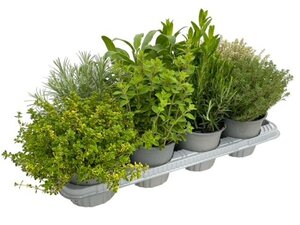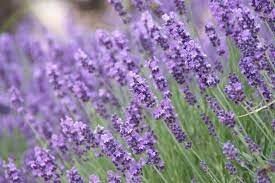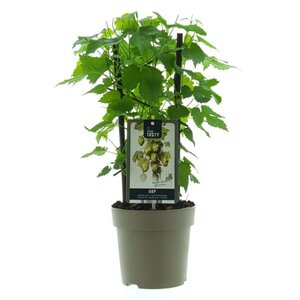Sage: A Versatile and Aromatic Herb for Your Garden
Sage (Salvia officinalis) is a beloved herb known for its aromatic leaves, culinary uses, and medicinal properties. It is a versatile addition to any garden, offering both aesthetic appeal and practical benefits. Sage’s silvery-green foliage and purple-blue flowers make it a beautiful and functional choice for herb gardens, borders, or containers. Whether you're a seasoned gardener or a beginner, sage is an easy-to-grow plant that will thrive with minimal care. This guide will provide you with all the information you need to cultivate healthy, productive sage plants.
Key Features of Sage
- Height: Grows to approximately 30-60 cm (12-24 inches) tall.
- Spread: Spreads to about 60 cm (24 inches) wide.
Ideal Growing Conditions for Sage
To ensure that your sage plant flourishes, it’s important to provide the right growing conditions. Sage is a hardy herb that thrives in a range of environments, but there are some key factors to consider for optimal growth.
Light Requirements
- Full Sun: Sage prefers full sun and requires at least 6-8 hours of direct sunlight per day. This exposure ensures robust growth and maximizes the plant's flavor and aroma. If you’re growing sage indoors, place it near a sunny window.
- Partial Shade: Sage can tolerate partial shade, especially in hot climates. However, reduced sunlight may lead to leggier growth and a milder flavor.
Soil and Watering
Proper soil and watering practices are essential for healthy sage plants:
- Soil: Sage thrives in well-drained, sandy, or loamy soil with a pH level between 6.0 and 7.0. Sage is not fussy about soil fertility but does best in moderately fertile conditions. If your soil is heavy or clay-like, amend it with sand or organic matter to improve drainage.
- Watering: Sage is drought-tolerant and prefers to be kept on the dry side. Water the plant deeply but infrequently, allowing the soil to dry out between watering sessions. Overwatering can lead to root rot, so it’s important to ensure that the soil remains well-drained.
Climate and Temperature
Sage is a resilient plant that can adapt to various climates, but certain conditions will help it thrive:
- Temperature: Sage is hardy in USDA Zones 4-8, meaning it can withstand a range of temperatures. It can tolerate frost but may need some protection in regions with severe winters. In hot climates, provide partial shade to protect the plant from excessive heat.
- Climate: Sage is well-suited to Mediterranean climates but can adapt to cooler or warmer regions. In colder areas, mulch the base of the plant in late autumn to protect it from freezing temperatures.
Fertilization and Pruning
To keep your sage plant healthy and encourage lush growth, regular fertilization and pruning are recommended:
- Fertilization: Sage is not a heavy feeder and generally does not require frequent fertilization. A light application of a balanced, all-purpose fertilizer in early spring will suffice. Over-fertilization can lead to excessive foliage growth at the expense of flavor and aroma.
- Pruning: Regular pruning is essential to maintain the shape of the sage plant and encourage bushier growth. Trim back the stems by one-third in early spring before new growth begins. Throughout the growing season, prune the plant regularly to remove spent flowers and leggy stems.
Harvesting and Using Sage
Sage is most flavorful just before it flowers, so timely harvesting will ensure the best results:
- Harvesting: You can start harvesting sage once the plant has reached about 15 cm (6 inches) in height. Use sharp scissors or pruners to cut the leaves or stems, leaving at least a third of the plant intact to allow for regrowth. The best time to harvest is in the morning after the dew has dried but before the sun is too strong.
- Using: Sage is a versatile herb that can be used fresh or dried. Fresh sage leaves are commonly used in stuffing, sauces, and as a seasoning for meats. To dry sage, bundle the stems together and hang them upside down in a cool, dry place. Once dried, crumble the leaves and store them in an airtight container away from light.
Common Pests and Diseases
While sage is generally resilient, it’s important to be aware of potential pests and diseases that can affect its health:
- Pests: Sage is resistant to many pests, but aphids, spider mites, and whiteflies can sometimes be an issue. If you notice an infestation, treat the plant with insecticidal soap or neem oil. Ensuring good air circulation around the plant can also help prevent pest problems.
- Diseases: Sage is prone to fungal diseases like powdery mildew, especially in humid conditions. To prevent this, water the plant at the base and avoid overhead watering. Good spacing between plants will also promote air circulation and reduce the risk of fungal issues.
Seasonal Care Tips
Adjusting your care routine according to the season will help your sage plant thrive year-round:
- Spring: Plant sage outdoors after the last frost or start seeds indoors 6-8 weeks before the last frost date. Fertilize lightly and prune the plant to encourage new growth.
- Summer: Water moderately and prune regularly to maintain the plant's shape and vigor. Harvest leaves frequently for culinary use.
- Autumn: Continue harvesting sage and reduce watering as the weather cools. In regions with mild winters, sage can remain in the ground year-round.
- Winter: In colder climates, mulch the base of the sage plant or cover it with a frost blanket to protect it from freezing temperatures. Reduce watering and allow the plant to go dormant until spring.
Conclusion
Sage is a must-have herb for any garden, offering a delightful blend of flavor, fragrance, and medicinal benefits. With its low-maintenance care requirements and hardy nature, sage is an excellent choice for gardeners of all skill levels. Whether grown in a sunny border, herb garden, or container, sage will reward you with a bountiful harvest of aromatic leaves that can be used fresh or dried in a variety of dishes. By following this care guide, you can ensure your sage plant remains healthy, productive, and a treasured part of your garden
- Size9cm
|
Standard Delivery per parcel* |
€7.95 |
|
* parcels up to 30kg or within dimensions volume |
|
|
* free delivery over €250 on standard items (excludes large/bulky items) |
|
|
* multiple purchases qualify for combined delivery |
|
|
For large items please ring us on 069-64084 to discuss delivery. |
|
We currently only deliver within the island of Ireland, other countries can be quoted for by contacting [email protected] or via telephone on 06964084
Standard Delivery is FREE on orders over €250*
All standard deliveries will be completed within 5-7 working days via Fastway Couriers, any delay to this delivery time, the customer will be notified by One of our staff.
The in-Store delivery charge will vary compared with online, in-store delivery charge is done on a case by case basis.
* Only mainland Ireland addresses qualify for free delivery.
Live Plants Delivery
Our live plants are packed with care and diligence by our staff, our horticulturists review each plant before despatch to ensure quality is maintained.
Live Plant delivery charges are not calculated on weight but on the space required per package to ensure safe delivery, so delivery charges may vary as some plants require more space than others when packed.
All live plants are despatched within 3-5 working days where possible, our couriers aim to deliver within 48 hours of despatch from our Garden Centre to allow the plant to arrive in healthy condition.
Click & Collect
Can’t wait for delivery? Why not try our FREE Click & Collect service? Simply make your purchase online and collect it from our store located in Croagh Co. Limerick. Our staff will contact you by phone when your order is ready for collection (Please allow 24 hours minimum). When collecting your item, call the store on 069-64084. We will then load into your car as required. This service is available in-store 9am – 6pm Monday – Saturday (No collections on Sundays)
Click here for more information about our shipping conditions.
You can pay your online order either by credit card or via Paypal.
If you have any further questions about the online order payment please contact us via 069 640 84 or mail.
Are you looking for %name"? We offer this product in our garden centre in Ballycannon, Croagh, near Kilmallock, Charleville, Limerick, Adare and Ballingarry. You can order Sage online or you can visit our garden centre in Ballycannon, Croagh, Limerick for more information about the product "Sage". We look forward to seeing you soon!
Write a review about "Sage"
We want to know your opinion! Write a review about the product “Sage”




